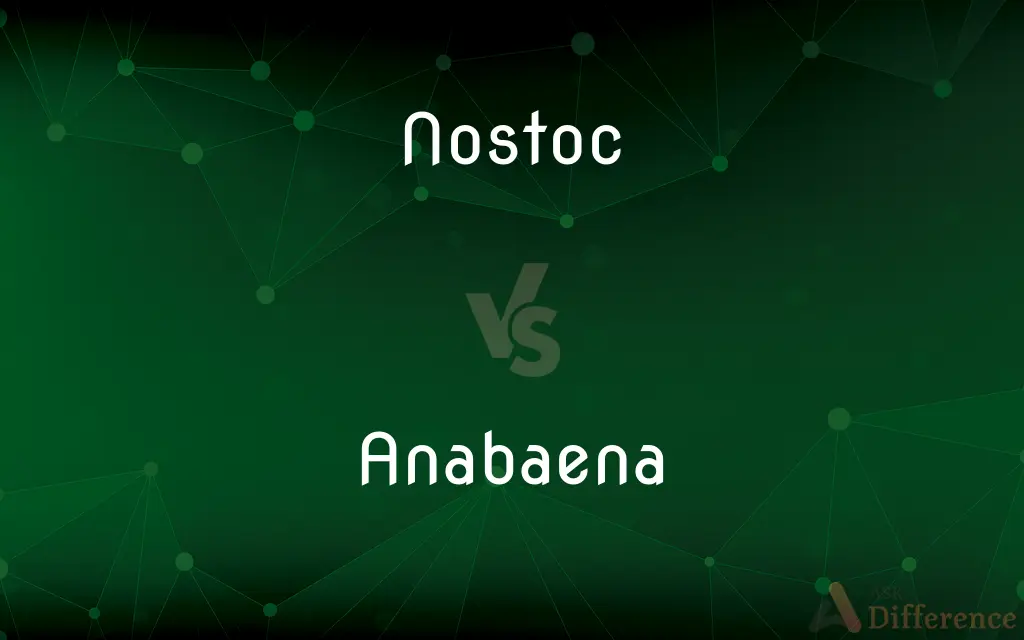Nostoc vs. Anabaena — What's the Difference?
Edited by Tayyaba Rehman — By Fiza Rafique — Updated on September 30, 2023
Nostoc and Anabaena are both cyanobacteria, with Nostoc forming gelatinous colonies and often found in water and soil, while Anabaena is known for its heterocysts that facilitate nitrogen fixation.

Difference Between Nostoc and Anabaena
Table of Contents
ADVERTISEMENT
Key Differences
Nostoc and Anabaena represent two distinct genera within the cyanobacteria family. While they share similarities, being photosynthetic prokaryotes that contribute to nitrogen fixation, they possess marked differences. Nostoc typically forms bead-like chains encapsulated in a gelatinous matrix. This structure allows Nostoc to survive in various habitats, from aquatic ecosystems to terrestrial environments, such as soils and rocks. In contrast, Anabaena exhibits filamentous structures without such extensive gelatinous matrices.
In the realm of biological nitrogen fixation, Anabaena stands out for its unique specialized cells known as heterocysts. These cells differentiate from normal cyanobacterial cells and are vital for the process of converting atmospheric nitrogen into ammonia. Nostoc, while also capable of nitrogen fixation, presents heterocysts less distinctively than Anabaena.
Another interesting aspect is the ecological significance of both genera. Nostoc can often be found in symbiotic relationships with plants, particularly in non-leguminous plants. These associations facilitate nitrogen availability to the host plant. Anabaena, on the other hand, plays a crucial role in freshwater ecosystems, and its presence can sometimes lead to algal blooms when conditions are favorable.
Comparison Chart
Structure
Forms bead-like chains within a gelatinous matrix
Exhibits filamentous structures without a gelatinous matrix
Heterocysts
Less distinctive compared to Anabaena
Known for its pronounced heterocysts
ADVERTISEMENT
Habitats
Found in both aquatic and terrestrial environments
Primarily in freshwater ecosystems
Symbiotic Relationships
Commonly found in symbiosis with non-leguminous plants
Less commonly found in symbiotic relationships
Ecological Significance
Contributes to nitrogen availability in various ecosystems
Can lead to algal blooms in favorable conditions
Compare with Definitions
Nostoc
Nostoc is a genus of cyanobacteria forming bead-like chains in a gelatinous sheath.
The moist rock was covered in colonies of Nostoc.
Anabaena
Anabaena is a cyanobacterial genus known for its filamentous structure.
Under the microscope, the distinct filaments of Anabaena were visible.
Nostoc
Nostoc colonies can be found in a variety of habitats from water to soil.
After the rain, Nostoc colonies appeared on the garden soil.
Anabaena
Anabaena plays a key role in the nitrogen cycle within its habitats.
Anabaena's nitrogen-fixing capability enriches aquatic ecosystems.
Nostoc
Nostoc can form symbiotic relationships with certain plants.
Some ferns establish beneficial associations with Nostoc.
Anabaena
Anabaena primarily thrives in freshwater ecosystems.
The pond water showed a significant presence of Anabaena.
Nostoc
Nostoc is known for its ability to fix nitrogen in diverse environments.a
Nostoc contributes to soil fertility through its nitrogen fixation.
Anabaena
Anabaena can sometimes lead to algal blooms in water bodies.
The rapid proliferation of Anabaena resulted in a noticeable algal bloom.
Nostoc
Nostoc's gelatinous colonies help protect it from environmental stressors.
Nostoc's gelatinous structure aids its survival during dry spells.
Anabaena
Anabaena contains specialized cells called heterocysts for nitrogen fixation.
The heterocysts in Anabaena enable it to convert atmospheric nitrogen.
Nostoc
Nostoc is a genus of cyanobacteria found in various environments that forms colonies composed of filaments of moniliform cells in a gelatinous sheath. The name Nostoc was coined by Paracelsus.Nostoc can be found in soil, on moist rocks, at the bottom of lakes and springs (both fresh- and saltwater), and rarely in marine habitats.
Anabaena
Anabaena is a genus of filamentous cyanobacteria that exist as plankton. They are known for nitrogen-fixing abilities, and they form symbiotic relationships with certain plants, such as the mosquito fern.
Nostoc
Any of various freshwater nitrogen-fixing cyanobacteria of the genus Nostoc that form spherical colonies of filaments embedded in a gelatinous substance.
Anabaena
Any of various freshwater cyanobacteria of the genus Anabaena that sometimes occur in drinking water and cause a bad taste and odor.
Nostoc
Any member of the genus Nostoc of cyanobacteria, found in a variety of environmental niches, that form colonies composed of filaments of moniliform cells in a gelatinous sheath.
Anabaena
Any cyanobacterium of the genus Anabaena.
Nostoc
A genus of algæ. The plants are composed of moniliform cells imbedded in a gelatinous substance.
Nostoc
Found in moist places as rounded jellylike colonies
Common Curiosities
What's distinctive about Anabaena's structure?
Anabaena has filamentous structures and is known for its pronounced heterocysts.
How does Nostoc typically appear?
Nostoc forms bead-like chains encapsulated in a gelatinous matrix.
What are Nostoc and Anabaena?
Both Nostoc and Anabaena are genera of cyanobacteria, which are photosynthetic bacteria.
Is Anabaena primarily aquatic?
Yes, Anabaena primarily exists in freshwater ecosystems.
Do both Nostoc and Anabaena fix nitrogen?
Yes, both Nostoc and Anabaena contribute to the process of nitrogen fixation.
Which genus is commonly found in symbiotic relationships with plants?
Nostoc often establishes symbiotic relationships, particularly with non-leguminous plants.
How do Nostoc colonies protect themselves?
The gelatinous sheath of Nostoc colonies offers protection from environmental stressors.
Where can Nostoc be found?
Nostoc can be found in both aquatic and terrestrial environments.
Why are Anabaena's heterocysts important?
Heterocysts in Anabaena play a crucial role in nitrogen fixation.
Do both genera belong to the same family?
Yes, both Nostoc and Anabaena belong to the cyanobacteria family.
Can Anabaena lead to algal blooms?
Yes, under favorable conditions, Anabaena can proliferate and lead to algal blooms.
Are Nostoc and Anabaena important for ecosystems?
Yes, both play significant roles in nitrogen cycling, enriching their respective habitats.
Which one is more common in soil, Nostoc or Anabaena?
Nostoc is more commonly found in soil environments compared to Anabaena.
Share Your Discovery

Previous Comparison
Soil vs. Land
Next Comparison
Dedendum vs. AddendumAuthor Spotlight
Written by
Fiza RafiqueFiza Rafique is a skilled content writer at AskDifference.com, where she meticulously refines and enhances written pieces. Drawing from her vast editorial expertise, Fiza ensures clarity, accuracy, and precision in every article. Passionate about language, she continually seeks to elevate the quality of content for readers worldwide.
Edited by
Tayyaba RehmanTayyaba Rehman is a distinguished writer, currently serving as a primary contributor to askdifference.com. As a researcher in semantics and etymology, Tayyaba's passion for the complexity of languages and their distinctions has found a perfect home on the platform. Tayyaba delves into the intricacies of language, distinguishing between commonly confused words and phrases, thereby providing clarity for readers worldwide.














































